Tag Archive for: immunology
Collaborating on Lung Cancer Treatment Decisions With Your Team
Collaborating on Lung Cancer Treatment Decisions With Your Team from Patient Empowerment Network on Vimeo.
Lung cancer specialist Dr. Tejas Patil discusses why active communication between patients and their healthcare team is essential when making care and treatment decisions.
Dr. Tejas Patil is an academic thoracic oncologist at the University of Colorado Cancer Center focused on targeted therapies and novel biomarkers in lung cancer. Learn more about Dr. Patil, here.
See More from Thrive Lung Cancer
Related Resources:
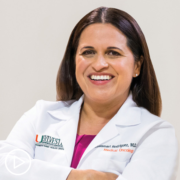
|
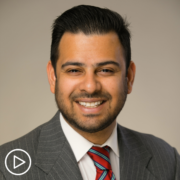
|
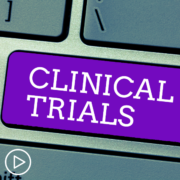
|
Transcript:
Katherine:
Where does shared decision-making come into play? When does it come into play?
Dr. Patil:
It comes in always.
So, shared decision-making is one of the most important things that patients can do with their providers. It’s really important when we think about treatments to not just be very cookie cutter and follow a recipe book for managing a patient’s lung cancer. It’s really important to individualize therapy. This is really important where patients’ values come in. What patients want to do with the time that they have, and what patients want to do with the treatment? How do they want to take certain treatments?
So, for example, I have a patient who’s a violinist and was faced with the possibility of receiving a type of clinical trial, but this trial caused neuropathy or numbness or tingling and would essentially render this patient unable to play the violin. This was an unacceptable treatment option for this patient, even though the data would suggest that it would work.
And that’s an example of where shared decision-making comes in because it’s more than just treating numbers. It’s really about taking care of people.
Katherine:
Yeah. Why is active communication between the patient and lung cancer team so important?
Dr. Patil:
Active communication is really important because it’s really one of the easiest ways for things — So, a breakdown of communication rather is a one of the easiest ways for gaps to occur in care. And when there is active communication, when a patient feels like they have an opportunity to reach their team members to connect with their providers, it builds trust. And I think trust is one of the more important elements in the management of patients. If patients can trust their provider and trust that their judgment is sound, then there is more likely to be a harmonious relationship that facilitates the shared decision-making.
Katherine:
When a patient is in active lung cancer treatment, how are they monitored?
Dr. Patil:
So, patients are monitored in a variety of ways. If they’re receiving chemotherapy or immunotherapy, typically a provider will see the patient with each infusion cycle. And so, depending on the length of time and the schedule of infusions, that sort of dictates how frequently we see our patients. When patients are receiving targeted therapies, specifically the pill-based forms, they can be monitored in concordance with the NCCN guidelines. And in my practice, I typically see patients every three months with imaging.
Now, if patients are having a hard time tolerating treatment, so they’re taking their oral pills but for whatever reason, we’re having a ton of side effects, we’re trying to figure out the dose. I might see my patients more frequently. But as a standard, if patients are tolerating their targeted treatment well, their scans look good, I usually see them every three months.
Expert Advice for Setting Lung Cancer Treatment Goals
Expert Advice for Setting Lung Cancer Treatment Goals from Patient Empowerment Network on Vimeo.
Dr. Tejas Patil, a lung cancer specialist from the University of Colorado Cancer Center, shares advice on how lung cancer patients can work with their healthcare teams to set treatment goals.
Dr. Tejas Patil is an academic thoracic oncologist at the University of Colorado Cancer Center focused on targeted therapies and novel biomarkers in lung cancer. Learn more about Dr. Patil, here.
See More from Thrive Lung Cancer
Related Resources:

|

|

|
Transcript:
Katherine:
When someone is considering therapy for non-small cell lung cancer, what advice do you have for setting treatment goals with their team?
Dr. Patil:
So, non-small cell lung cancer has seen some remarkable progress in the last 20 years, but it’s still a very serious disease. One of the main expectations I set with patients is that I will guide them through this journey, but that there’s going to be a lot of changes in their day-to-day. When we look at someone who’s receiving targeted therapy, in general I upfront tell patients that the model that I’m trying to emulate with targeted therapies is very similar to HIV. I remind patients that in 2022, we still cannot cure HIV, but we can give a very effective antiviral therapies that put their viral count to zero.
And patients with HIV now can live really full rich lives. And that’s the model that we’re trying to replicate with targeted therapies. With immunotherapies, I set patients the expectation that immunotherapy has been a major advance in the management of lung cancer. And many patients are living very full lives as a result of using immune therapies. But it’s not for everyone, and I do enforce and or rather emphasize is a better word, the concept of taking things day-by-day. I think it’s really helpful when patients have a diagnosis like this to not spiral out of control and think about all possible future outcomes, but to really work with the data that we have at the moment.
Questions to Ask Before Participating in a Lung Cancer Clinical Trial
Questions to Ask Before Participating in a Lung Cancer Clinical Trial from Patient Empowerment Network on Vimeo.
When considering clinical trial participation, what questions should patients ask their healthcare team? Dr. Tejas Patil, a lung cancer specialist at the University of Colorado Cancer Center, shares advice on what patients need to know when considering joining a clinical trial.
Dr. Tejas Patil is an academic thoracic oncologist at the University of Colorado Cancer Center focused on targeted therapies and novel biomarkers in lung cancer. Learn more about Dr. Patil, here.
See More From Lung Cancer Clinical Trials 201
Related Resources:

|

|

|
Transcript:
Katherine:
When considering clinical trial participation, what questions should patients be asking their healthcare team?
Dr. Patil:
So, couple of questions that I think are really important for patients to ask their healthcare team is what is the current standard of care? So, if you’re enrolling in a clinical trial, you want to know that you’re receiving some kind of drug.
And its expected effectiveness should be compared to what is considered the current standard of care for whatever line of therapy that is. The other practical questions that patients should be asking is what is the schedule of therapy? So, how frequently am I supposed to come in? Am I supposed to get a biopsy?
Am I supposed to get blood draws? Most clinical trials will come with a schedule or a calendar for patients, and it’s helpful for them to look that over and see what’s being asked of them. And then the last thing is what are the known side effects? Now I always tell patients with a clinical trial, we don’t always know the side effects as part of the reason we’re doing the clinical trial.
But if there’s some experience or if the doctors enrolled other similar patients in this trial asking what are the foreseeable side effects is actually really important.
When to Consider a Clinical Trial for Lung Cancer Treatment
When to Consider a Clinical Trial for Lung Cancer Treatment from Patient Empowerment Network on Vimeo.
When it comes to non-small cell lung cancer treatment options, where do clinical trials fit in? Dr. Tejas Patil of the University of Colorado Cancer Center explains how he discusses clinical trial participation with patients.
Dr. Tejas Patil is an academic thoracic oncologist at the University of Colorado Cancer Center focused on targeted therapies and novel biomarkers in lung cancer. Learn more about Dr. Patil, here.
See More From Lung Cancer Clinical Trials 201
Related Resources:

|

|
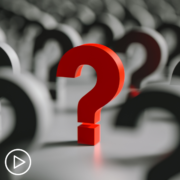
|
Transcript:
Katherine:
When it comes to non-small cell lung cancer treatment options, where do clinical trials fit in?
Dr. Patil:
So, clinical trials are very important to advancing our knowledge and advancing our ability to care for patients in the best way possible. What I frequently get asked from patients is am I going to be a guinea pig for a clinical trial? And I think it’s really important to emphasize that clinical trials are comparing the best-known standard of care to something new.
So, in effect you would never be a guinea pig. You would really just be receiving what is the best-known standard of care. And that would be compared to some novel approach to treating cancer. In general, I’m very encouraging of patients to enroll in clinical trials.
I discuss the pros and cons of this because there are logistical concerns to keep in mind when patients are thinking about enrolling in clinical trials. If a patient enjoys traveling, and enjoys wanting to spend time with their family, that has to be balanced against the regimented schedule that some clinical trials may have.
If they live in a rural part of the state and they have to travel three to four hours weekly, that’s a decision that has to be had and be made. But in general, if a patient is eligible and willing, I’m strongly encouraging that patients enroll in clinical trials to help further the knowledge of the field.
Katherine:
Yeah. Are there clinical trial options available for patients who have already been treated with another therapy?
Dr. Patil:
Yes. So, the clinical trials come in variety of forms and patients are eligible at various stages.
So, there are some clinical trials that require patients to be newly diagnosed. And so, the trial would be the “first therapy” that they receive. But many trials actually I would say the majority of clinical trials in lung cancer are looking at patients who’ve progressed on the first line of treatment and are now facing the possibility of receiving second line treatments or further. So, that’s a common place for patients to enroll in clinical trials.
The Latest Lung Cancer Research Updates From ASCO 2022
The Latest Lung Cancer Research Updates From ASCO 2022 from Patient Empowerment Network on Vimeo.
Dr. Tejas Patil from the University of Colorado Cancer Center shares the latest news in lung cancer research and treatment from the 2022 American Society of Clinical Oncology (ASCO) Annual Meeting, including an update on immunotherapy.
Dr. Tejas Patil is an academic thoracic oncologist at the University of Colorado Cancer Center focused on targeted therapies and novel biomarkers in lung cancer. Learn more about Dr. Patil, here.
See More From INSIST! Lung Cancer
Related Resources:

|

|

|
Transcript:
Katherine:
Researchers came together earlier this summer at the annual ASCO meeting. Were there highlights from the meeting that lung cancer patients should know about?
Dr. Patil:
Right. So, the ASCO ’22 meeting this year had some really interesting publications. So, for me, the key publications that I thought were kind of interesting from ASCO ’22, 2022, one was a publication looking at the role of immunotherapy in patients who are – have a very high PD-L1 expression, so greater than 50 percent. And there’s –
Katherine:
Reminds us what PDL is.
Dr. Patil:
Oh, yes, of course. So, PD-L1 is a biomarker. It’s a predictive biomarker that lets us know whether some patients will benefit from immunotherapy. It’s also prognostic because if patients have a high PD-L1 score, they tend to do better with immunotherapy than patients who have a low PD-L1 score.
Katherine:
Okay.
Dr. Patil:
Now the interesting data that was presented was a pooled analysis of all the immunotherapy trials to date. And there’s been this ongoing question in lung cancer as to whether patients should get chemo with immunotherapy or whether they should just get immune therapy alone.
And this study showed that if you have a very high PD-L1 score, it is potentially possible to just use immune therapy and forgo chemotherapy. And I thought that was a very interesting analysis.
There’s also several other papers that came out as well. Mostly there was a lot of interest in something called circulating tumor DNA. So, let me just take a step back. This is a type of molecule that can be detected in the blood that can help determine whether cancer is present in your blood or not. And there was a lot of publications at ASCO looking at using a concept called minimal residual disease.
So, when we treat patients with early-stage lung cancer, a big question is how do we know they’re cured or not cured? And a lot of abstracts and publications this ASCO were looking at this concept of minimal residual disease. So, if I can detect some cancer in your blood after you’ve had cured curative therapies, we’re – we have a problem because there’s still cancer around and we’re detecting it in the blood.
And I think this type of approach is going to really inform how we think about early-stage lung cancer management in the future.
What Testing Should Take Place After Non-Small Cell Lung Cancer Treatment?
What Testing Should Take Place After Non-Small Cell Lung Cancer Treatment? from Patient Empowerment Network on Vimeo.
It’s well-known that patients should undergo testing before choosing lung cancer therapy, but what testing should take place following treatment? Lung cancer specialist Dr. Tejas Patil, from the University of Colorado Cancer Center, discusses the role of testing after treatment.
Dr. Tejas Patil is an academic thoracic oncologist at the University of Colorado Cancer Center focused on targeted therapies and novel biomarkers in lung cancer. Learn more about Dr. Patil, here.
See More From INSIST! Lung Cancer
Related Resources:

|

|

|
Transcript:
Katherine:
We know that patients should undergo testing before choosing therapy, but what testing should take place following treatment?
Dr. Patil:
That’s a really good question. And it’s a complex question depending on the type of treatment that the patient is receiving. So, broadly speaking in lung cancer, we’ve separated the field into two types of treatments.
Patients with lung cancers will get molecular testing at the onset, right? When they’re diagnosed to look for what’s called a driver oncogene. So, these are mutations that can be targeted with pill-based treatments. And if patients have these mutations, there’s about 10 of these right now and several in development, then the patients can receive a targeted therapy.
However, if they don’t have these mutations, then the standard of care right now is some kind of chemotherapy with immunotherapy. Now, the question asked was what kind of testing do you do after diagnosis? And that really depends on which camp you’re in. So, if you’re in the targeted therapy camp, my general practice has been to repeat molecular testing upon progression. The reason is that patients who are receiving targeted therapies typically evolved some kind of resistance to targeted therapy.
Broadly speaking, you can categorize these as on target or off target resistance, but the major reason for doing repeat molecular testing is to understand a mechanism of resistance and then hopefully develop a new treatment with that knowledge. Now for the camp that doesn’t receive targeted therapies, let’s say they receive chemotherapy and immunotherapy, there it gets a little bit more nuanced.
And if there is a role for repeating a biopsy and looking for dynamic changes in the patient’s cancer, but it is not routine and should be done with consultation with a thoracic oncologist. And really the idea here is that if patients who are on chemo immunotherapy progress, any additional molecular testing should really help inform what the next line of treatment will be and sometimes that can be a clinical trial.
How Does Biomarker Testing Impact Non-Small Cell Lung Cancer Care?
How Does Biomarker Testing Impact Non-Small Cell Lung Cancer Care? from Patient Empowerment Network on Vimeo.
Biomarker testing identifies certain genes, proteins, or other molecules present in a biologic sample. Dr. Tejas Patil, of University of Colorado Cancer Center, discusses how results from these tests can be used to determine a treatment approach for non-small cell lung cancer (NSCLC).
Dr. Tejas Patil is an academic thoracic oncologist at the University of Colorado Cancer Center focused on targeted therapies and novel biomarkers in lung cancer. Learn more about Dr. Patil, here.
See More From INSIST! Lung Cancer
Related Resources:

|

|
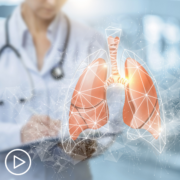
|
Transcript:
Katherine:
Biomarker testing is important prior to choosing therapy for non-small cell lung cancer. What is this test and how long does it take to get results?
Dr. Patil:
That is a great question. So, a biomarker is a biological molecule found in blood or other body fluids or tissues that is a sign of a normal or an abnormal process.
Or let me reframe that as it represents having some kind of medical condition or disease. Now, it’s a very broad definition. Basically, a biomarker can be used to see how well the body responds to a treatment for a disease or a condition. And when we look at it from a genetic perspective, sometimes the term that you’ll see is a molecular marker or a signature molecule.
So, these are terms that are sort of interchangeable with biomarkers. But the role of a biomarker is to help ascertain how well the body responds to a certain medical intervention, broadly speaking.
Katherine:
Okay. What question should a patient ask their doctor about test results?
Dr. Patil:
So that’s a very complicated question, and I will do my best to answer it succinctly. So, my personal view is that for any test to be meaningful, it should impact medical decision-making in some very concrete way.
Specifically, with biomarkers, the result should either be prognostic or predictive and I’ll define what those terms are. So, a predictive biomarker is one that helps determine if a certain therapy will be effective. So, I’m going to use lung cancer as an example. In EGFR mutation in non-small cell lung cancer allows a doctor to prescribe an EGFR targeted therapy called osimertinib (Tagrisso). Therefore, in this example, the EGFR mutation is predictive.
It opens the door for this targeted option that would otherwise not have been available if the patient did not have this EGFR mutation. A prognostic marker is a little different. This is the type of marker that helps categorize risk. So, in the same example I used earlier, that patient may have an EGFR mutation.
They can also have a different mutation called TP53. Now this TP53 mutation doesn’t influence therapy. It’s not targetable, but it does influence risk.
And so, there’s been a lot of emerging data to show that patients with TP53 mutations have worse outcomes on targeted therapies than patients without TP53. And in that case, that mutation is what we call a prognostic biomarker.
What Is Maintenance Therapy for Non-Small Cell Lung Cancer?
What Is Maintenance Therapy for Non-Small Cell Lung Cancer? from Patient Empowerment Network on Vimeo.
Lung cancer expert Dr. David Carbone responds to a patient question about the purpose of maintenance therapy for lung cancer and what to expect.
Dr. David Carbone is a medical oncologist and professor of internal medicine at The Ohio State University. Dr. Carbone is also co-leader of the Translational Therapeutics Program at the OSUCCC – James, where serves as director of the Thoracic Oncology Center. Learn more about Dr. Carbone, here.
See More From INSIST! Lung Cancer
Related Resources:
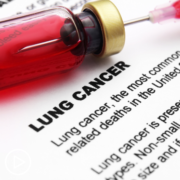
|
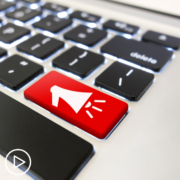
Why Non-Small Cell Lung Cancer Patients Should Speak Up About Symptoms and Side Effects |
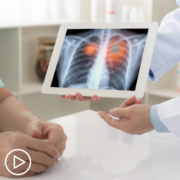
|
Transcript:
Katherine:
Lindsay sent in this question: “My doctor has talked about putting me on maintenance therapy following my treatment regimen. What is maintenance therapy for lung cancer?”
Dr. Carbone:
So, many of our treatments have a maintenance phase, and I’m not sure which treatment she’s talking about. But even with chemotherapy, now, if people are on chemotherapy alone, will usually use a double chemotherapy to start, and then will drop one of the chemos after a few cycles, and then continue the other as a maintenance.
A more typical regimen today is a combination of two chemos and an immunotherapy. And generally, we’ll stop the more toxic chemotherapy after a few cycles and continue the less toxic chemotherapy plus the immunotherapy, usually for up to two years.
After chemo-radiation, you’d have a maintenance immunotherapy as well. So, maintenance therapy is just a lower-intensity therapy after your initial therapy, designed to keep the cancer from coming back.
Immunotherapy for Lung Cancer Treatment: What to Expect
Immunotherapy for Lung Cancer Treatment: What to Expect from Patient Empowerment Network on Vimeo.
Dr. David Carbone responds to a viewer question related to the symptoms, side effects, and efficacy of immunotherapy for non-small cell lung cancer.
Dr. David Carbone is a medical oncologist and professor of internal medicine at The Ohio State University. Dr. Carbone is also co-leader of the Translational Therapeutics Program at the OSUCCC – James, where serves as director of the Thoracic Oncology Center. Learn more about Dr. Carbone, here.
See More From INSIST! Lung Cancer
Related Resources:

|
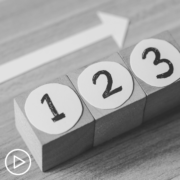
|

|
Transcript:
Katherine:
We have received some questions from audience members earlier on. And so, David writes, “My care team has suggested immunotherapy to treat my lung cancer. I’m optimistic about the results, but nervous about symptoms and side effects. What can I expect?”
Dr. Carbone:
The immunotherapy is a potent therapy, but you have to understand, you’re dealing with lung cancer, which is a rapidly fatal disease when untreated. So, there’s a balance there. There’s a risk/benefit calculation that happens in picking any treatment.
And it turns out that I would say most lung cancer patients today have immunotherapy as part of their first treatment. Immunotherapy ramps up your own immune system to make it more effective at seeing the cancer, which has previously grown because it’s hidden itself behind a kind of invisibility cloak, and these immunotherapies remove this invisibility cloak so that the immune system can see it.
But at the same time, this process is a normal process that’s used to keep the immune system in check, and keep the immune system from attacking normal tissues, as well. So, it’s pretty common that we see people on immunotherapy have some kind of autoimmune side effect.
The most common side effect with immunotherapy is a skin rash, and usually it’s mild, and you just treat it with a topic corticosteroid, and it’s not a big issue. But it sometimes can be very severe. Like everything else, there’s a spectrum. I would say most patients have no skin problems; some have severe; and it’s almost always treatable. The next most common side effect is thyroid endocrine disorders. So, people will get thyroid function loss. And so, this is something that we follow carefully in the clinic, and people who are on immunotherapy.
And when we start seeing their thyroid levels going down, we just start them on thyroid medication, and that completely fixes that problem. So, but it’s usually permanent, and even after they stop immunotherapy, they’ll need to take thyroid medicines and adjust their thyroid levels.
And then, there’s a whole slew of other possible side effects that are less common. Some are very severe. Less than one percent of patients have a severe side effect called colitis, which causes diarrhea, which can even be life-threatening, but is also treatable if detected early. Very uncommon to be so severe, but patients should let their doctors know if they experience unusual diarrhea.
You can also have inflammation in your lungs called pneumonitis. So, if there’s an onset of shortness of breath, of course, you’ll tell your doctor, and that can be treated, as well. And anything else, there’s a huge list of other things. Arthritis, uveitis, other things that happen, but are pretty rare.
What Treatments Are Available for Non-Small Cell Lung Cancer?
What Treatments Are Available for Non-Small Cell Lung Cancer? from Patient Empowerment Network on Vimeo.
Dr. David Carbone provides an overview of currently available treatments for non-small cell lung cancer patients, including clinical trials, and reviews factors that influence treatment decisions.
Dr. David Carbone is a medical oncologist and professor of internal medicine at The Ohio State University. Dr. Carbone is also co-leader of the Translational Therapeutics Program at the OSUCCC – James, where serves as director of the Thoracic Oncology Center. Learn more about Dr. Carbone, here.
See More From INSIST! Lung Cancer
Related Resources:
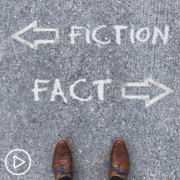
|

|

|
Transcript:
Katherine:
What are the current approaches for treating non-small cell lung cancer?
Dr. Carbone:
Well, that’s a complex question. The basic modalities are surgery, which is really still what we prefer, if we can detect it early; radiation therapy; and medical therapy.
And medical therapy can be divided into chemotherapies of some sort – what we call targeted therapies, based on genetic abnormalities in the tumor – and then, immunotherapies to harness the immune system to fight cancer. Those are the three major kinds of therapies.
Katherine:
It seems like patients really do have a lot of options, which is a good thing for them. But how do you then decide which treatment is most appropriate for a given patient?
Dr. Carbone:
Well, it’s not straightforward. When I started 35 years ago, it really wasn’t clear whether any treatment made any difference, and we actually did a large, randomized trial of doing nothing versus treating, and showed that we could improve survival by a month or two with the currently available treatments. Now, we have a huge toolbox of types of treatments and combinations of treatments. And it really requires a careful analysis of the characteristics of the tumor to pick the best therapy.
And specifically, for the adenocarcinomas, the most common type, we now do a detailed genetic analysis on all of the tumors, which can completely change the type of treatment people get and the prognosis, and result in being able to match a pill-type targeted therapy to a particular genetic abnormality with really high efficacy and low toxicity. And there are other markers we use for immunotherapy choices. It’s become quite complicated.
Katherine:
Where do clinical trials fit in, Dr. Carbone?
Dr. Carbone:
Well, I like to say that clinical trials are tomorrow’s standard of care available today, and all of the new treatments that I’m talking about for lung cancer that have made this dramatic difference in survival and quality of life: They’ve all come because of basic science research, understanding how cancers grow, designing drugs, and using them in people in an intelligent way.
Historically, we used to just grind up tree bark or dig things up from the bottom of the sea, and test them in tissue culture to see if they killed cancer cells a little more than normal cells. But today, the treatments we have are based on science, and the success of these treatments is very high compared to what they were historically.
And the way we determine whether a treatment is effective is through something called a clinical trial, where generally the new treatment is compared to the standard treatment.
And if there is no standard treatment, we still do sometimes use placebo-controlled trials, but often that’s placebo plus some chemotherapy, versus the new drug plus that same chemotherapy.
So, it’s really not a placebo-only type situation. But the trials are designed to rigorously test whether the drug improves outcomes, and are an extremely important step in developing these new drugs and finding new things to help patients.
Expert Advice for Navigating Non-Small Cell Lung Cancer Care and Treatment
Expert Advice for Navigating Non-Small Cell Lung Cancer Care and Treatment from Patient Empowerment Network on Vimeo.
Dr. David Carbone, a lung cancer specialist, discusses factors to consider when choosing treatment for non-small cell lung cancer (NSCLC). Dr. Carbone provides and overview of the type of treatment for NSCLS, why biomarker testing is essential, and shares advices for playing an active role in your care.
Dr. David Carbone is a medical oncologist and professor of internal medicine at The Ohio State University. Dr. Carbone is also co-leader of the Translational Therapeutics Program at the OSUCCC – James, where serves as director of the Thoracic Oncology Center. Learn more about Dr. Carbone, here.
See More From INSIST! Lung Cancer
Related Resources:

|
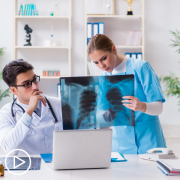
|

|
Transcript:
Katherine:
Hello, and welcome. I’m Katherine Banwell, your host for today’s program. Today, we’re going to discuss how you can insist on the best care for your non-small cell lung cancer.
Before we get into the discussion, please remember that this program is not a substitute for seeking medical advice.
Please refer to your healthcare team about what might be best for you. All right, let’s meet our guest today. Joining me is Dr. David Carbone. Dr. Carbone, welcome. Would you please introduce yourself?
Dr. Carbone:
Thank you, Katherine. It’s a pleasure to be here. I’m David Carbone. I’m the director of the thoracic oncology center at Ohio State University in Columbus, Ohio. And I have a 35-year clinical and research interest in lung cancer, and I’m a medical oncologist myself.
Katherine:
Excellent, thank you. Thank you for joining us today. Before we get into our discussion, which will focus on non-small cell lung cancer, let’s talk about the types of lung cancer. What is the difference between non-small cell lung cancer and small cell lung cancer?
Dr. Carbone:
Well, I like to tell patients every cancer is different from every other cancer, but they can be broadly categorized in two different categories, small cell and non-small cell.
And this derived from decades ago when small cell lung cancer just looked different under the microscope than non-small cell lung cancer. And different small cells can look different, and now we’re sub-typing small cells. But in general, small cells are treated pretty similarly. Non-small cells are divided into two main groups, the squamous cell carcinomas and the adenocarcinomas.
Adenocarcinomas have a variety of subtypes, as well, and then there are a few of the non-small cell lung cancers that are clearly non-small cell but don’t fit into either of those two categories, and they’re called large-cell or not otherwise specified.
And then, there’s a whole slew of rare types of lung cancers that we probably don’t have time to discuss, and mesothelioma that happened in the chest.
Katherine:
Right. Is one type of lung cancer more common than the other?
Dr. Carbone:
So, the vast majority of lung cancers are the non-small cell lung cancers, about 85 percent. And among the non-small cell lung cancers, most of those are adenocarcinomas or non-squamous. Decades ago, squamous was the most common type, and in some parts of the world, it still is. But in the United States, it depends on the region; 60, 70 percent of lung cancers are adenocarcinomas.
Katherine:
Right, okay, that makes sense. I’d like to pivot and talk about treatment for a couple of moments. What are the current approaches for treating non-small cell lung cancer?
Dr. Carbone:
Well, that’s a complex question. The basic modalities are surgery, which is really still what we prefer, if we can detect it early; radiation therapy; and medical therapy.
And medical therapy can be divided into chemotherapies of some sort – what we call targeted therapies, based on genetic abnormalities in the tumor – and then, immunotherapies to harness the immune system to fight cancer. Those are the three major kinds of therapies.
Katherine:
It seems like patients really do have a lot of options, which is a good thing for them. But how do you then decide which treatment is most appropriate for a given patient?
Dr. Carbone:
Well, it’s not straightforward. When I started 35 years ago, it really wasn’t clear whether any treatment made any difference, and we actually did a large, randomized trial of doing nothing versus treating, and showed that we could improve survival by a month or two with the currently available treatments. Now, we have a huge toolbox of types of treatments and combinations of treatments. And it really requires a careful analysis of the characteristics of the tumor to pick the best therapy.
And specifically, for the adenocarcinomas, the most common type, we now do a detailed genetic analysis on all of the tumors, which can completely change the type of treatment people get and the prognosis, and result in being able to match a pill-type targeted therapy to a particular genetic abnormality with really high efficacy and low toxicity. And there are other markers we use for immunotherapy choices. It’s become quite complicated.
Katherine:
If we’re breaking it down to staging, let’s start with that. What are the stages?
Dr. Carbone:
Right. So, lung cancer, like many cancers, is staged I, II, III, and IV, and of course there’s now As, Bs, and Cs, and subcategories of those. But the basic distinction patients need to know has some utility.
So, the stage I lung cancers, in general, are small tumors that aren’t invading into anything, that haven’t spread anywhere to none of the lymph nodes, to no other structures; and they’re the tumors that we like to find. And they’re the ones whose optimal treatment is surgery, with a good cure rate.
Stage IIs, in general, are those lung cancers that are like stage I, except they involve the nearby lymph nodes in the lung that are called hilar lymph nodes, and those have also a high cure rate, but not quite as so high with surgery; and generally, are treated with surgery followed by chemotherapy, and now, immunotherapy.
Stage III is what we call locally advanced. It’s still only in the chest, but it invades some important structure or has multiple lymph nodes that are deep within the chest. And some of these are surgically resectable, but the majority of stage IIIs, I would say, are not surgically resectable, and are treated generally with chemoradiation, again followed by immunotherapy.
With the stage IV lung cancers, really, that is the lung cancer that’s spread outside the chest; typically, to bones, brain, or liver, or elsewhere in the body.
And that is typically not resectable; though again, there’s exceptions to each of these general rules, and you really need to have that multi-disciplinary evaluation of your cancers to determine the best therapy. But in general, stage IV lung cancers are not surgical candidates, not treated upfront as radiation candidates, and they’re generally treated with medical treatments that go throughout the body, and treat spots of cancer wherever they are.
Katherine:
How about when we look at general health and comorbidities? How do those influence the treatment choices that you would make?
Dr. Carbone:
Every patient is different, like every cancer is different, and we have patients who are 20-year-olds and patients who are 90-year-olds; and patients who’ve taken care of themselves, and those that haven’t done so well taking care of themselves.
More than half of patients, even though they used to smoke, are ex-smokers. And so, they generally are in better condition, but we have to take into account frailty and presence or absence of diabetes, kidney disease, and all those other comorbidities, which are common in lung cancer, which has a median age of onset in the upper-60s, where people have these kinds of comorbidities.
We try not to use age alone as a factor, because there are many robust 90-year-olds, and there are many 50-year-olds on oxygen. So, we have to look at the complete picture to plan the best therapy.
Katherine:
Yeah. What about treatment side effects? How does that bear on what you decide to treat the non-small cell lung cancer?
Dr. Carbone:
Well, unfortunately, we don’t cure most lung cancers. And so, our treatments are designed to prolong life and improve quality of life.
So, we’re very aware of the impact of our treatments on the quality of a patient’s life, and we’ve worked hard, over the years, to improve the risk-benefit ratio of our treatments, so to speak. And again, when I started, we didn’t have good nausea medicines, and people got desperately sick to have a six-week prolongation in survival, and that was really of questionable utility.
But now, even the chemotherapies that we give are generally super-well tolerated. The chemotherapies used in lung cancer are often – people will say, “I feel a little tired for a couple of days, but then, I’m fine,” and they’d often continue to work. Most, I would say, have no nausea; they have no significant side effects; and the immunotherapies, on average, people have very few side effects. They can hardly tell they’re getting the treatment, though sometimes the side effects can be significant.
Like everything I’m telling you, there’s always a spectrum.
Katherine:
Of course.
Dr. Carbone:
And the targeted therapies: Again, most often, people have very mild side effects, with maybe a little skin rash or a slight loose stool, or something. But often, it’s insignificant compare to the magnitude of the benefit they get from these treatments.
Katherine:
Let’s talk about biomarker testing. What is it, first of all, and what are you looking for, exactly, when you receive the results?
Dr. Carbone:
Well, you have to order the results, so you have to know what to order. And we already touched on it a little bit. The genetic analysis of a tumor has become central to picking a therapy. And when I say “genetic analysis,” that is what you’re referring to as one of the biomarker tests we use.
Unfortunately, it’s true that many patients have therapies started without waiting for the results of these biomarker tests, and that really can have a negative impact on their care, because the results of this testing can make the difference between chemotherapy or a pill. It’s a totally diametrically different therapy.
So, these genetic tests look for things that we call driver mutations, and these are alterations in the genes of your cancer that are not present in the rest of your body; they’re not passed down to your children, or need to get looked for in your brother or your sister, like some of the breast cancer mutations you may hear about.
These are mutations that are present in the tumor that act like light switches, and they turn the cancer on to grow like crazy.
And through scientific research, we’ve discovered many of these in lung cancer, where, if we can find the specific driver mutation, many of these have specific drugs that can turn that switch back off. And virtually 100 percent or very close to every patient where we can find that matching drug to their driver will have some tumor shrinkage.
And it’s quite remarkable, but we need to do that matching, because these new drugs only work in that subset of patients with that mutation, and that’s why it’s so important to do that matching. And now, we have eight or 10 of these types of mutations that need to be looked for.
Katherine:
Where do clinical trials fit in, Dr. Carbone?
Dr. Carbone:
Well, I like to say that clinical trials are tomorrow’s standard of care available today, and all of the new treatments that I’m talking about for lung cancer that have made this dramatic difference in survival and quality of life: They’ve all come because of basic science research, understanding how cancers grow, designing drugs, and using them in people in an intelligent way.
Historically, we used to just grind up tree bark or dig things up from the bottom of the sea, and test them in tissue culture to see if they killed cancer cells a little more than normal cells. But today, the treatments we have are based on science, and the success of these treatments is very high compared to what they were historically.
And the way we determine whether a treatment is effective is through something called a clinical trial, where generally the new treatment is compared to the standard treatment.
And if there is no standard treatment, we still do sometimes use placebo-controlled trials, but often that’s placebo plus some chemotherapy, versus the new drug plus that same chemotherapy.
So, it’s really not a placebo-only type situation. But the trials are designed to rigorously test whether the drug improves outcomes, and are an extremely important step in developing these new drugs and finding new things to help patients.
Katherine:
A lung cancer diagnosis often has a certain stigma associated with it, but the majority of that is not based in fact. So, I’d like to play a little game with you called Fact or Fiction. All right? All right, first one. Fact or fiction: Lung cancer is a disease of the older population.
Dr. Carbone:
If you have lungs, you can get lung cancer. That’s it. I’ve seen 20-year-old lung cancer patients. So, I think it can happen to anybody, and unfortunately, things like the CT screening programs are limited to people over the age of 50, but I’ve had many patients in their 30s and 40s. So, if you have lungs, you can have lung cancer.
Katherine:
Okay. Next one, fact or fiction: Quality of life is greatly diminished after undergoing treatment for lung cancer.
Dr. Carbone:
I completely – fiction. I actually tell people often their quality of life is dramatically improved after starting treatments, and that’s my goal.
And with the new treatments, that’s often true. People will tell me within a week that they feel so much better on the treatment than they did before. So, that’s our goal. Our goal is not to make you feel worse. Our goal is to make you feel better.
Katherine:
Of course. All right, last one. Fact or fiction: There are no effective treatments for advanced lung cancer.
Dr. Carbone:
So, the average survival for lung cancer years ago was four to six months from the time of diagnosis to death. That’s bad. And now, we are seeing in these subsets of patients years and years of survival with simple even pill-type treatments or immunotherapies. And even with the immunotherapies, sometimes you get treatments for a year or two, and then we stop; and we have patients who are years later, off of all treatments for metastatic lung cancer, still with no evidence of disease.
So, that is definitely fiction. We have highly-effective treatments for lung cancer. But unfortunately, like everything else, and like I’ve said multiple times, it’s not true for everyone. Our treatments aren’t ideal. Sometimes for a particular patient we can’t find a matching treatment, the standard treatments don’t work, and nothing we can find makes a difference. But I would say you never know that until you try, and for the vast majority of patients, we can definitely give them prolonged, good-quality life. And so, I think that that’s definitely fiction.
Katherine:
Okay, thank you. We have received some questions from audience members earlier on.
And so, David writes, “My care team has suggested immunotherapy to treat my lung cancer. I’m optimistic about the results, but nervous about symptoms and side effects. What can I expect?”
Dr. Carbone:
The immunotherapy is a potent therapy, but you have to understand, you’re dealing with lung cancer, which is a rapidly fatal disease when untreated. So, there’s a balance there. There’s a risk/benefit calculation that happens in picking any treatment.
And it turns out that I would say most lung cancer patients today have immunotherapy as part of their first treatment. Immunotherapy ramps up your own immune system to make it more effective at seeing the cancer, which has previously grown because it’s hidden itself behind a kind of invisibility cloak, and these immunotherapies remove this invisibility cloak so that the immune system can see it.
But at the same time, this process is a normal process that’s used to keep the immune system in check, and keep the immune system from attacking normal tissues, as well. So, it’s pretty common that we see people on immunotherapy have some kind of autoimmune side effect.
The most common side effect with immunotherapy is a skin rash, and usually it’s mild, and you just treat it with a topic corticosteroid, and it’s not a big issue. But it sometimes can be very severe. Like everything else, there’s a spectrum. I would say most patients have no skin problems; some have severe; and it’s almost always treatable. The next most common side effect is thyroid endocrine disorders. So, people will get thyroid function loss. And so, this is something that we follow carefully in the clinic, and people who are on immunotherapy.
And when we start seeing their thyroid levels going down, we just start them on thyroid medication, and that completely fixes that problem. So, but it’s usually permanent, and even after they stop immunotherapy, they’ll need to take thyroid medicines and adjust their thyroid levels.
And then, there’s a whole slew of other possible side effects that are less common. Some are very severe. Less than one percent of patients have a severe side effect called colitis, which causes diarrhea, which can even be life-threatening, but is also treatable if detected early. Very uncommon to be so severe, but patients should let their doctors know if they experience unusual diarrhea.
You can also have inflammation in your lungs called pneumonitis. So, if there’s an onset of shortness of breath, of course, you’ll tell your doctor, and that can be treated, as well. And anything else, there’s a huge list of other things. Arthritis, uveitis, other things that happen, but are pretty rare.
Katherine:
Lindsay sent in this question: “My doctor has talked about putting me on maintenance therapy following my treatment regimen. What is maintenance therapy for lung cancer?”
Dr. Carbone:
So, many of our treatments have a maintenance phase, and I’m not sure which treatment she’s talking about. But even with chemotherapy, now, if people are on chemotherapy alone, will usually use a double chemotherapy to start, and then will drop one of the chemos after a few cycles, and then continue the other as a maintenance.
A more typical regimen today is a combination of two chemos and an immunotherapy. And generally, we’ll stop the more toxic chemotherapy after a few cycles and continue the less toxic chemotherapy plus the immunotherapy, usually for up to two years.
After chemo-radiation, you’d have a maintenance immunotherapy as well. So, maintenance therapy is just a lower-intensity therapy after your initial therapy, designed to keep the cancer from coming back.
Katherine:
Right. Okay. We have one other question, this one from Shelley: “Is lung cancer hereditary? I’m curious if my children should undergo genetic counseling, since I was diagnosed with lung cancer.”
Dr. Carbone:
Well, that’s a simple, complicated question.
So, in general, lung cancer is not hereditary. It’s not like familial breast cancer or ovarian cancer, or those kinds of cancers, or retinoblastoma. Most cases of lung cancer are caused by environmental exposure to cigarette-smoking or radon, and are not passed on to your kids genetically, though there is shared exposure, right?
There are some really rare genetic predispositions that we sometimes find on these biomarker panels.
But the vast, vast majority of lung cancers are not heritable, and you don’t need to worry about your kids, except to tell them not to smoke, and test for radon.
Katherine:
Patients can sometimes feel like they’re bothering their healthcare team with their comments and questions. Why is it important for patients to speak up, and become a partner in their own care?
Dr. Carbone:
So, it’s a fact that when patients get the diagnosis of lung cancer, everything changes in their lives. They suddenly have a whole new vocabulary thrown at them. It’s like their doctor is speaking French to them. They have to trust their life to a person they’ve never met before, and a whole cadre of people coming in and talking to them and poking them and running through scanners.
It’s very difficult for someone whose biggest concern was what to make for dinner that night, and now has a diagnosis of lung cancer, to really comprehend what’s going on. And lung cancer is complicated, so I recommend that patients really try their best to have at least a basic understanding of what’s going on, where their cancer is. I always show the patient their scans.
“Your cancer is here; this is what it looks like; that’s why you’re having that pain over there, because you have this spot here. Your genetic testing shows this and this, and that’s why it’s important, and that’s why we’re using this drug to match this mutation.” And these are things patients will understand if doctors will explain it to them.
And similarly, the side effects. Lung cancer patients tend to be tough people. They’ll say, “It’s not so bad, I feel better; but the side effect is not so bad. I’m just not going to tell them.” And it even happens in clinic that they’ll tell me they feel fine, and then they’ll tell the nurse that they hurt in their left elbow. And I have to go back in and ask them some more questions on that.
So, it’s extremely important to feel comfortable in communicating with your doctor, asking questions; “Why am I getting this scan? Why are we using this treatment? Is this the best treatment? Are there clinical trials available? I have this new symptom, x, y, z,” because symptoms are often much easier to treat when you catch them early than when you catch them late.
And you don’t get a medal for being a tough guy in this situation. Tell your doctor if you have pain, and they can manage it. Tell them if you’re short of breath, and they can help you feel better. They can’t help you if you don’t tell them, and you are your own best advocate in this situation. Ask questions about the treatment, and why that’s the best one for you; and, as I said, about clinical trials.
Katherine:
Excellent. Thank you so much. It’s important for people to remember that.
And I just want to remind our audience that you can send in your questions to question@powerfulpatients.org, and we’ll get them answered, hopefully, on future programs.
So, Dr. Carbone, just to wrap things up, what are you excited about in lung cancer research right now, and what would you like to leave the audience with?
Dr. Carbone:
Well, there’s a lot to be excited about in lung cancer right now. There’s new therapies being approved all the time. We have more new approvals in the last few years than in the last few decades put together. So, there’s a lot to be excited about.
But there’s still a lot of room for improvement, and there are a lot of patients who still suffer and die from lung cancer. So, my message to patients would be to make sure they get their biomarker testing before they start treatment. And it doesn’t mean to get the tests sent off and start on Joe Random treatment, until the test comes back. This means wait until the test comes back before starting treatment.
And then, I would recommend getting second opinions, if a patient is in a private practice without availability of clinical trials, to investigate if there might be new clinical trials available for them; again, before starting treatment, because sometimes even that first dose of standard chemo may make you ineligible for a trial. So, No. 1 is biomarkers.
Katherine:
All right. Thank you so much for joining us today.
Dr. Carbone:
Well, you’re very welcome. Thank you for helping patients better understand how to deal with this disease.
Katherine:
And thank you to all of our partners.
To learn more about lung cancer and to access tools to help you become a proactive patient, visit powerfulpatients.org. I’m Katherine Banwell. Thanks for joining us today.
How Will You Know if Your Lung Cancer Treatment Is Working?
How Will You Know if Your Lung Cancer Treatment Is Working? from Patient Empowerment Network on Vimeo.
How do lung cancer experts determine if a treatment approach is working? Expert Dr. Heather Wakelee explains how treatment effectiveness is monitored and what should be analyzed when treatments stop working.
Dr. Heather Wakelee is a thoracic medical oncologist and deputy director of the Stanford Cancer Institute where she also serves as the division chief of medical oncology. Learn more about Dr. Wakelee, here.
See More From INSIST! Lung Cancer
Related Programs:

|

How Are Targeted Therapy and Immunotherapy Used in Lung Cancer Care? |
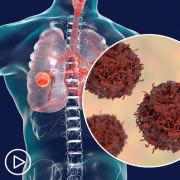
What Are the Advantages of Newer Lung Cancer Treatment Approaches? |
Transcript:
Katherine:
We have a question that we received from an audience member earlier. Jeff asks, “How do you know if your lung cancer treatment is working?”
Dr. Wakelee:
So, there are a lot of ways of knowing if treatment is helping. So, the one I rely on the most is, “Does the patient overall feel better?” That is difficult to say exactly how. Sometimes people are having breathing problems; they feel that that’s better. Sometimes their energy’s lower. They feel better. It can be vague. We also use scans. So, we tend to get scans, depending on the treatment we’re giving, every couple of months plus or minus, sometimes, every three months to help track what’s actually going on. But occasionally, there are discrepancies.
So, sometimes, the scan, is it better? Is it not better? Can’t really tell. And then, you’re always taking that, “How does the patient feel?” So, usually, if the scans are better, the patient feels better. It’s easy. Usually if the patient’s feeling worse and the scan looks worse, clear decision. Not a good one, but clearly, we need to do something different. But sometimes, you’re left, and especially this happens with the first scan because you get a scan, it takes a little while, you start the new treatment, then you get the next scan, how much of the changes happened before you started the new one and how much didn’t? So, these can be more challenging conversations, but generally if the patient’s feeling a little bit better, the scan’s unclear, we usually say, “You know, let’s give this treatment a little bit more time.” We also, I think your question was specifically around how do we tell if it’s working, but you also often need to be thinking about, “Well, what’s it doing that’s negative to the person and is that potential, those side effects worth the benefits we are or are not seeing?”
So, it’s kind of all of those things together. It can be a bit complex.
Katherine:
What goes into the decision to change therapies if it becomes necessary?
Dr. Wakelee:
So, when we’re thinking about making a change, the way I always look at it is, is where we are today still okay or not? And, if it’s not, that would be because clearly the cancer’s growing or clearly the side effects are just not tolerable. Then, we decide together with the patient we need to do something different. And, when we think about what do we do next, we look at what have we’ve already done, did it work or not, if not, let’s do something more different. And so, let’s think about something that might be somewhat similar. When we’re dealing with targeted therapies, we have ways to try to figure out what changed in the tumor that made it now resistant or not working with that treatment.
And so, with some of the pill drugs, there’s been a lot of research and understanding how does the tumor change that helps it evade, get away from, be resistant to whatever treatment you’re on.
And then, sometimes, we have other pill drugs that work in that particular setting, not always. With immune therapy, we’re trying to better understand why does the immune therapy stop working?
Sometimes you can add back to it, like, you can add chemotherapy back to immune therapy alone or sometimes you can do radiation with immune therapy to get that response back. Or, add other combinations to it. So, that’s another thing that we’re working on. And then, like I said, if someone hasn’t ever had chemotherapy and the tumor’s become resistant, we’re going to be thinking a lot about chemo because that can play a role against so many different reasons that the cancer might not be responding to whatever treatments someone’s on. And then also, looking at how the patient’s feeling and doing, what their overall what we call “performance status, ” their sort of overall health, and how well do we feel with them that they’re going to be able to tolerate the next treatment because, you’re always having to weigh how much is this likely to help, and how might this harm in finding the right balance.
What Are the Goals of Lung Cancer Treatment?
What Are the Goals of Lung Cancer Treatment? from Patient Empowerment Network on Vimeo.
The goals of lung cancer treatment can vary depending on the stage. Expert Dr. Heather Wakelee explains how lung cancer stage is determined and shares insight about the goals of treatment at each stage.
Dr. Heather Wakelee is a thoracic medical oncologist and deputy director of the Stanford Cancer Institute where she also serves as the division chief of medical oncology. Learn more about Dr. Wakelee, here.
See More From INSIST! Lung Cancer
Related Resources:
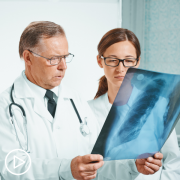
|
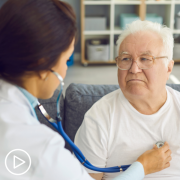
|

|
Transcript:
Katherine:
Let’s turn to treatment, Dr. Wakelee. On a basic level, what are the goals of treatment for lung cancer?
Dr. Wakelee:
So, with lung cancer, we’d love to cure everybody, that’s the ultimate goal, and do it in a way where people are able to continue living their life as they were before the cancer diagnosis. The ways that we do it, first of all, we’ve got to find the cancer, and that’s where screening is such an important aspect of things. If we can find the cancer at an earlier stage, we’re more likely to be able to cure someone.
So, what do I mean by “earlier stage?” Well, when a tumor first develops, usually, there is a single cell that develops a mutation, meaning a change in the gene, which gives that cell an advantage so it doesn’t die the way it’s supposed to. And then, it keeps growing, and dividing, and making new cells. And those over time get to a large enough size that they are the cancer. And given more time, those cancer cells start to spread into other parts of the body, usually first into what we call the lymph nodes, and from there then into other organs in the body. And this stage refers to health or how the cancer spread. So, the stage I cancer is still in that ball of cancer. Stage II means that it’s spread into some lymph nodes. Stage III is it spread into more lymph nodes, usually in the center part of the chest or mediastinum, and that’s where it starts to be much more difficult for the surgeons to be able to truly remove all of the cancer.
And then stage IV means that the cancer is not something that we’re going to be able to remove with surgery. It’s spread either within the lung to the lining of the lung or it has spread to other organs in the body. And so, when we talk about those stages that I, II, III, IV, it’s a bit more complicated than that. But, I think for most people, if they just think about it as stage I, just the cancer, stage II, lymph nodes and the lungs, stage III, lymph nodes in the center, and then stage IV, elsewhere, that’s a good way to kind of wrap your head around it.
And when we talk about stage I and II, that’s the truly early stage where we hope to be able to cure people with surgery. Surgery alone is enough for the majority of people with stage I cancer, and for maybe half, a little more than half of people with stage II. So, how can we be better than that? Well, that’s where there’s been a lot of new advances. So, adding chemotherapy after surgery can help a lot of stage II patients.
If the tumor genomic testing biomarkers shows that there’s a mutation called EGFR, we now know that there’s a pill drug that people can take that would prolong the time to when the cancer might come back. And then, just very recently, there was stated that that immune therapy drugs
IV can also prolong time to when the cancer comes back and maybe improve cure if the tumor has that biomarker called PD-L1. So, that’s that early stage. So it’s, again, getting more and more complicated and emphasizing that you’ve got to understand the biomarkers of the tumor to know how to best help someone.
When we move to stage III, some have surgery, but when you can’t have surgery, then we do the chemotherapy and the radiation. That’s the key part of the treatment there. And, we also know that immune therapy can be really helpful for a lot of patients when it’s given after the chemo and radiation’s completed. And then for stage IV, I talked about that already, which is you’ve gotta do the biomarkers to figure out the best treatments for some people starting with a targeted pill drug is the right thing if their tumor has those right gene mutations.
For other people, immune therapy alone might be an option if the PD-L1 level is very high and they don’t have one of those gene mutations in the tumor. And for a lot of people, chemotherapy or chemotherapy plus immunotherapy is the right strategy.
Katherine:
Would you help the audience understand the types of therapy for small cell lung cancer specifically?
Dr. Wakelee:
Yes. So, small cell still has the same kind of staging, but it’s a little bit more simple. We talk about extensive stage or limited stage. And what that has to do with is we rarely do surgery for small cell. It tends to have spread earlier. There are a few cases where that’s done, but normally, we divide it up into limited or extensive. And when we talk about that, limited is the radiation doctors can get all of the cancer in one radiation field, and then radiation plus chemotherapy is the standard approach to try to cure. If it’s more extensive than that, then it becomes extensive stage.
And, the best treatment are going to be chemotherapy plus those immune therapy drugs added together.
And so, the chemotherapy drugs that we use for non-small cell and small cell, the platinum drugs play a role in all of it. The drug we partner is a little bit different. There’s a drug etoposide we use a lot in small cell and a lot of other options for non-small cell. And then, the immune therapy drugs, there are a lot of options that are fairly similar for both small cell and for non-small cell.
In-Depth Testing for Lung Cancer Prognosis and Treatment
In-Depth Testing for Lung Cancer Prognosis and Treatment from Patient Empowerment Network on Vimeo.
How is in-depth lung cancer testing used in determining lung cancer prognosis and treatment? Expert Dr. Heather Wakelee shares insight about biomarker testing, genomic testing, and how test results may impact treatment options.
Dr. Heather Wakelee is a thoracic medical oncologist and deputy director of the Stanford Cancer Institute where she also serves as the division chief of medical oncology. Learn more about Dr. Wakelee, here.
See More From INSIST! Lung Cancer
Related Programs:

|
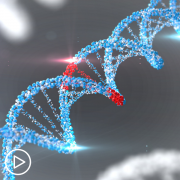
What Are Biomarkers and How Do They Impact Lung Cancer Treatment Options? |

How Are Targeted Therapy and Immunotherapy Used in Lung Cancer Care? |
Transcript:
Katherine:
Dr. Wakelee, but what is genomic or biomarker testing?
Dr. Wakelee:
So, we are struggling with how to have one unifying way of describing it because it’s so complicated. So, to me, biomarker testing is any aspect of the tumor that helps us choose the best treatment for that patient. And so, it’s a very broad term. And, within biomarker testing, there are several different ways that we look at it.
So, one is to look at what proteins are on the cell’s surface. And, we do that by having stains that we use to stain the tissue. So again, complicated, but when a piece of tissue is taken out of the person, part of the tumor is removed. It’s sliced into little tiny slices, which are then put on glass slides that can be looked at under the microscope. And, that’s how the pathology doctors can look and see, “Ah, this looks like cancer,” or, “It doesn’t look like cancer.” When it does look like cancer, you can then put on stains, so basically, different colored antibodies that will light up if that particular protein is there. And so, that helps us figure out for sure that this started in the lung because there are specific proteins that are only found in lung. So, that’s one way we used it, and this is an older technology. But we also can use that to look for how much of this PD-L1 protein is expressed.
And so, that’s an important biomarker, but it’s not based on genomics, which is when we’re talking about the DNA.
Then, we have the genomic testing, and that’s when we’re looking at the genome of the tumor and how that genome is different. And, that’s that DNA or RNA testing. We talk about it with the next-gen sequencing. So, “sequencing,” any of those terms are all meaning we’re looking at some aspect of what makes the tumor genes and therefore the proteins made by the tumor different than the rest of the genes in the person.
And so, that testing, that genomic testing can be done on either the tumor specimen or that’s where we can do blood tests that will be able to pull out those bits of the DNA that are from the tumor versus from the person and help us figure out what’s going on with the cancer. So, when we talk about biomarkers, the whole picture, and when I’m talking with patients who are diagnosed with lung cancer, we talk about well, there’s chemotherapy treatment, which is good for almost everybody. There is targeted therapy.
Targeted therapy is usually based on those genomic tests, and the genomic tests can be done either on the tissue or on blood. But, they’re really important to have a full understanding of the
tumors to do a comprehensive or next-gen sequencing analysis of the tumor or DNA. And then, you have the immune therapy where that PD-L1 biomarker is important. So, that’s the way I think about it, and the biomarkers are really critical for helping us figure out what’s the best path forward for any individual patient.
When I started treating lung cancer patients 20 years ago, we only had chemotherapy. And now, for metastatic disease, with using the right biomarkers, we can figure out so much more about the cancer to be able to personalize the treatment, for many patients, being able to offer pill therapies that are somewhat less toxic and highly active and give people more time. And now, we’re in the immune therapy revolution, which is helping a whole other group of patients living with lung cancer to be able to live with quality life for much longer. And the pace of discovery is just going up so quickly. And, I think that’s what I’m most hopeful about is just how much attention is being paid on lung cancer and finding better therapies that are going to help more people for a longer period of time.



